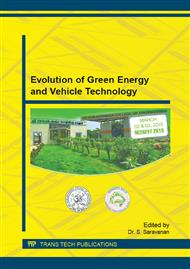[1]
Dubreuil A, Foucher F, Mounaim-Rousselle C, Effect of EGR Chemical Components and Intake Temperature on HCCI Combustion Development, SAE 32 (2006).
DOI: 10.4271/2006-32-0044
Google Scholar
[2]
Hua Zhao, HCCI and CAI engines for the automotive industry, 1st edition, Wood head publishing limited, CRC press, (2007).
Google Scholar
[3]
Ramos JI, Internal combustion engine modelling, 1st edition, Hemisphere Publishing Corporation.
Google Scholar
[4]
Akhilendra Pratap Singh, Avinash Kumar Agarwal, Combustion characteristics of diesel HCCI engine: An experimental investigation using external mixture formation technique, Applied Energy 99 (2012) 116–25.
DOI: 10.1016/j.apenergy.2012.03.060
Google Scholar
[5]
Hernandez JJ, Sanz-Argent J, Benajes J, Molina S, Selection of a diesel fuel surrogate for the prediction of auto-ignition under HCCI engine conditions, Fuel 87 (2008) 655– 665.
DOI: 10.1016/j.fuel.2007.05.019
Google Scholar
[6]
Juan J Hernandez, JosepSanz-Argent, Esperanza Monedero –Villalba, A reduced chemical kinetic mechanism of a diesel fuel surrogate (n heptane/toluene) for HCCI combustion modelling, Fuel 133 (2014) 283–291.
DOI: 10.1016/j.fuel.2014.05.029
Google Scholar
[7]
A. K. Agarwal, Bio fuels (alcohols and bio diesel) applications as fuels for internal combustion engines, Prog. Energy Combust. Sci 33 (2007) 233.
Google Scholar
[8]
Daly DT, Nag P, Combustion modeling of soot reduction in diesel and alternate fuels using CHEMKIN, SAE 1 (2001) 1239.
DOI: 10.4271/2001-01-1239
Google Scholar
[9]
Shi. X, Pang. Y, Mu. H, He. S, Shuai. J, Wang. H, Chen. R, Li, Emission reduction potential of using ethanol–biodiesel–diesel fuel blend on a heavy-duty diesel engine, Atmospheric Environment 44 (2006) 2567–2574.
DOI: 10.1016/j.atmosenv.2005.12.026
Google Scholar
[10]
Li. H, Zhen. L, Xingcai. Z, Wu-gao, Y. Jian-guang, Physico-chemical properties of ethanol–diesel blend fuel and its effect on performance and emissions of diesel engines, Renewable Energy 30 (2005) 967–976.
DOI: 10.1016/j.renene.2004.07.010
Google Scholar
[11]
Thring R. H . Homogeneous charge compression ignition (HCCI) engines, SAE (1989).
DOI: 10.4271/892068
Google Scholar
[12]
Magnus S, John E, An investigation of the relationship between measured intake temperature and combustion phasing for premixed and DI HCCI engines, SAE 1900 (2004) 1271-1286.
DOI: 10.4271/2004-01-1900
Google Scholar
[13]
Risberg P, Kalghatgi, Hans Erik A, Auto-ignition quality of diesel like fuels in HCCI engines, SAE 2127 (2005) 883-893.
DOI: 10.4271/2005-01-2127
Google Scholar
[14]
Kong SC, Marriott CD, Reitz RD, Modeling and experiments of HCCI engine combustion using detailed chemical kinetics with multidimensional CFD, SAE 1026 (2001) 1007-1044.
DOI: 10.4271/2001-01-1026
Google Scholar
[15]
Hasegawa R, Hiromichi Y, HCCI combustion in DI diesel engine, SAE 0745 (2003)1070-1076.
Google Scholar
[16]
DaeSik Kim, Chang Sik Lee. Improved emission characteristics of HCCI engine by various premixed fuel sand cooled EGR. Fuel 85 (2005) 695-704.
DOI: 10.1016/j.fuel.2005.08.041
Google Scholar
[17]
Arjan H, Jonas G, Ingemar D, Operation of a DI diesel engine with variable effective compression ratio in HCCI and conventional diesel mode, SAE 0177 (2005) 405-418.
DOI: 10.4271/2005-01-0177
Google Scholar
[18]
John B Heywood, Internal combustion engine fundamentals, 1st ed. New York: McGraw Hill Book Company, (1989).
Google Scholar
[19]
Yasar H, Soyhan HS, Walmsley H, Head B, Sorusbay C, Double-Wiebe function: An approach for single-zone, HCCI engine modeling, Applied Thermal Engineering 28 (2008) 1284–1290.
DOI: 10.1016/j.applthermaleng.2007.10.014
Google Scholar
[20]
Scott B Fiveland, Dennis N Assanis, Development and validation of a quasi-dimensional model for HCCI engine performance and emission studies under turbocharged conditions, SAE 1757 (2002).
DOI: 10.4271/2002-01-1757
Google Scholar
[21]
Feng Tao, Rolf D Reitz, David E Foster. Revisit of Diesel Reference Fuel (n- Heptane) Mechanism Applied to Multidimensional Diesel Ignition and Combustion Simulations, SAE (2007).
Google Scholar
[22]
Krasnoperov LN, Chesnokov EN, Stark H, Ravishankara AR, Elementary reactions of formyl (HCO) radical studied by laser photolysis—transient absorption spectroscopy, Proceedings of the Combustion Institute (2005) 935.
DOI: 10.1016/j.proci.2004.08.223
Google Scholar
[23]
Noel L, Maroteaux F, Ahmed A, Numerical Study of HCCI Combustion in Diesel Engines Using Reduced Chemical Kinetics of n-Heptane With Multidimensional CFD Code, SAE 01 (2004) (1909).
DOI: 10.4271/2004-01-1909
Google Scholar


